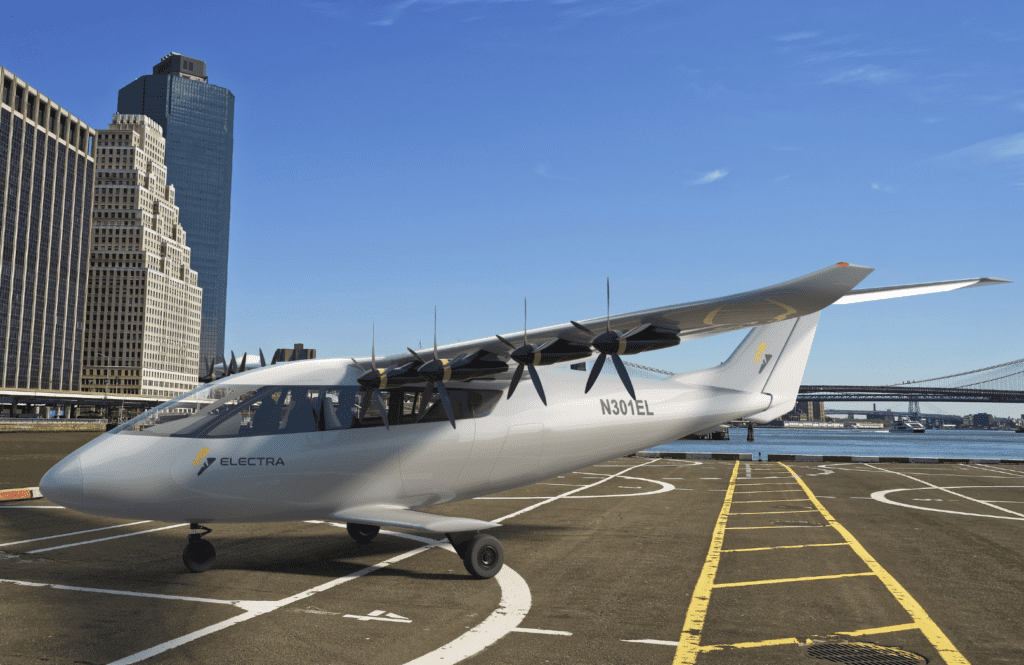
Electra has acquired Airflow, and the combined teams are consolidating efforts to develop an electric short take-off and landing (eSTOL) aircraft. (Photo courtesy of Electra)
In an announcement this week, Electra.aero shared news of its acquisition of the company Airflow. Both companies have developed electric short take-off and landing (eSTOL) aircraft, and Airflow’s eSTOL business will now be consolidated into the Electra brand. Marc Ausman, co-founder and CEO of Airflow—now Chief Product Officer of Electra—believes that working together with Electra will be a much stronger approach for bringing their eSTOL aircraft to market. “We are combining the best of both worlds,” he told Avionics International in an interview, “taking the best of what each company has learned.” The most immediate objective for Electra is to fly a technology demonstrator within the next 12 months.
The teams from both Electra and Airflow had prior experience in developing electric aircraft and working for major aircraft OEMs. Based on that experience, Ausman explained, each company had independently determined that an eSTOL model was the optimal method for bringing electric propulsion to market.
The Electra brand now includes the teams from both Airflow and Electra, and an even larger combined order book—with letters of interest for about 800 aircraft, said Ausman. “Many of the folks from Airflow fill in gaps in the team at Electra,” and vice versa, he added.
Airflow’s existing partnerships offer potential opportunities for growth to Electra. In October 2021, Airflow began partnering with Plug Power, a leading hydrogen fuel cell company. In what Ausman describes as a long-term partnership, the collaborators “are actively developing the technology to bring hydrogen fuel cells and other hydrogen technology to smaller Part 23 aircraft. That helps move us towards our ultimate goal of sustainability.” A key point of consideration in this partnership is determining what the entire product family will look like in the future, he noted.

“We’re really thinking about ways that the aircraft can be used outside of traditional runways.” – Marc Ausman, Chief Product Officer of Electra (Photo courtesy of Airflow)
Another potential area for growth for Electra is moving to an adjacent market, such as the seaplane market. The eSTOL model is well-suited for this specific market, Ausman said. “We’re really thinking about ways that the aircraft can be used outside of traditional runways. We think we can grow significantly [in the seaplane market] and help our customers grow,” he explained.
At the end of last year, Airflow entered into a partnership with Tailwind Air to explore development of an amphibious seaplane powered by distributed electric propulsion. Tailwind’s current fleet, offering a scheduled seaplane service from New York to Boston Harbor, is currently made up of Cessna Caravan amphibious seaplanes.
Another one of Airflow’s existing partnerships is with the company Pipistrel, an electric airplane manufacturer. Pipistrel agreed to supply motors, motor controllers, and batteries for Airflow’s proof-of-concept aircraft, which was intended to be a modified version of an existing fixed-wing design.
Ausman told Avionics that the first launch will be a hybrid electric aircraft. The next generation will be hydrogen electric, “then ultimately, when batteries are good enough, we’ll have a pure battery electric aircraft.” Unless there are any major breakthroughs in the technology, he views battery development as a path of incremental improvements.
The eSTOL model itself will combine aspects from both Airflow’s and Electra’s development programs. Each company found success with certain types of customers, resulting in an order book that is very complementary, Ausman commented. The new Electra team will develop an aircraft with “the broadest market appeal for regional air mobility and urban air mobility.”
Electra hopes to fly a technology demonstrator as soon as possible—in the upcoming year, Ausman shared. Following that, they will work on the pre-production prototype aircraft. Both teams had very similar milestones in mind as they developed their eSTOL aircraft, he added, saying, “We’re combining efforts in terms of what we’ve learned and what customer needs are moving forward—to [achieve] those milestones and be able to fly as soon as we can.”
Electra announced an investment from Lockheed Martin at the beginning of this year to support Electra’s goal of flying a technology demonstrator. In February, the U.S. Air Force awarded Electra a Phase III Small Business Innovation Research (SBIR) contract as part of the Agility Prime program, following a $1.5 million investment from the USAF in 2021. In March of this year, the USAF also awarded Electra a Small Business Technology Transfer (STTR) Phase II contract in which Electra will collaborate with the Massachusetts Institute of Technology (MIT) for developing flight control systems to integrate into its eSTOL aircraft.